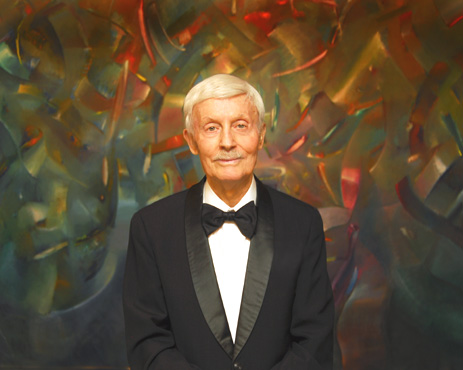|
|
About the Artist

Gerard Francis Tempest
February 23, 1918 – July 26, 2009
painter/sculptor/architect
protégé' to the forerunner of Surrealism,
Giorgio de Chirico
Gerard Francis Tempest, a multifaceted internationally renowned artist, sculptor and architect was known as the father of Abstract Spiritualism and the protégé of Giorgio de Chirico, the forerunner of Surrealism.
Tempest was born in Italy in 1918 and immigrated to America with his family at the age of 11. He knew at a young age that he wanted to be an artist. In the American public school system he studied art with private instructors and attended summer sessions at the Boston Museum School. At the age of 19 he founded his own sign-painting company covering the New England states with seventeen employees.
In 1941 at the age of 23 Tempest was drafted into the United States Army as a Private. He quickly rose through the ranks and became an officer attached to the 82nd Airborne Division under General Omar N. Bradley. During World War II, Tempest fought in the major campaigns and battles in Europe, including in Normandy on D-Day, the Battle of Hürtgen Forest, the Battle of the Bulge, and with the French Underground in the Liberation of Paris. Tempest was portrayed as one of the main characters in the book and film “Is Paris Burning?” And in 1944 Tempest was awarded the Bronze Star Medal for distinguished service under the Allied Command in Europe. Tempest is also known to have designed the 101st Airborne Division’s insignia (the "Screaming Eagle").
After World War II, in 1945, Tempest moved to Massachusetts. Turning down a full scholarship in mathematics at M.I.T. to pursue his art, he entered the Boston Museum School, studying under Max Beckman and Oscar Kokoschka, the great Abstract Expressionists. In 1948 he moved to Rome to study at the Accademia di Belle Arti and then studied privately under Giorgio de Chirico who nominated him as his protégé.
Tempest first introduced "Abstract Spiritualism" in 1957 at an exhibition in Rome. Since then, this theme has characterized his work. Somewhat Modern Impressionistic in color and translucency, "Abstract Spiritualism" engenders the Spirit through a resounding explosion of light that emanates from within each object.
Tempest said “In search of spiritual essence in objects and life, I was inspired by the scientific discoveries of energy forces around the atom nucleus. From this I found the space between objects devoid of matter but full of energy … the space or energy I was in search of. I contemplated the space and an undulating wave-like ribbon appeared. The ribbon became my symbol, and was suggestive of infinite movement and light in space. All this has the power, energy, and light of the spirit.”
In 1967 Tempest received the Gold Medal at the Cannes Art Festival and in 1982 and then again in 1990, Tempest was honored and recognized for his achievement and contribution to contemporary art, when his work was made a part of the permanent collection of the Vatican Museum.
During his career, Tempest's unique body of work has appeared in numerous solo and group exhibits throughout the United States, France and Italy and has placed his works in both private and public collections throughout the world.
He is an artist who for over ninety years has purposely pursued his destiny outside the art-world mainstream. However, the collection of his recent lyrical works reveals that he is one of the best American artists of his era.
Tempest was recently recognized in 2008 by the South Carolina legislature in a joint resolution citing his artistic accomplishments and his World War II service. In 2009 he was nominated to the South Carolina Hall of Fame.
A man of many talents and exceptional energy, Tempest has influenced and touched the lives of thousands of people around the world.
|
|
|